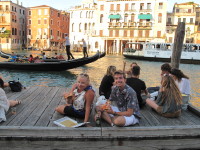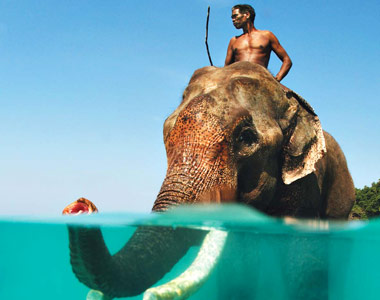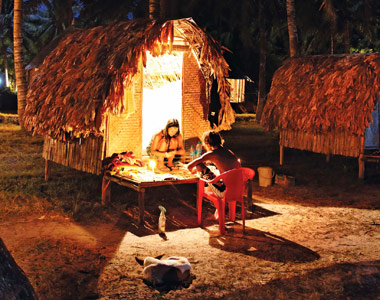This Just In
Babar and Me and the Deep Blue Sea from Condé Nast Traveler on Concierge.com
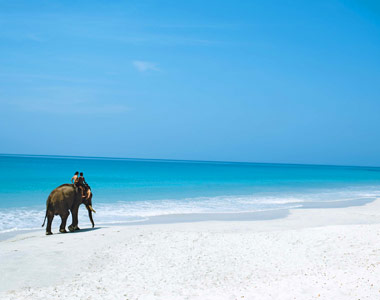
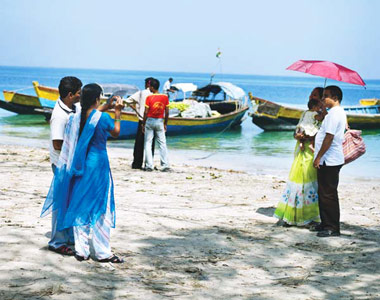 I love wonderful stories of places I want to go. When I found this story I wanted to share it with my readers. Enjoy!
I love wonderful stories of places I want to go. When I found this story I wanted to share it with my readers. Enjoy!
The Andaman Islands, closed to foreigners until 1995, are the ultimate tropical mystery in that cabinet of wonders called India. Tony Perrottet loses himself in a place of unearthly perfection, where crabs climb trees, elephants swim, and man has barely left his mark
“Just don’t swim in front of him,” whispered Sanjit Biswas, a worker at the jungle lodge where I was staying in the Andaman Islands. “That can spook him.” My guide from Bangalore nodded in solemn agreement. “Rajan’s a little bit fussy. Sometimes he just won’t go in, and nobody can really force him.”
Okay, I thought, as I tiptoed through the shallows of Beach No. 7 to meet my monstrous swimming buddy. No sudden moves or I could be squashed like a chapati.
Rajan finished off a pile of bananas and thudded down to the gently lapping waterline. His mahout, a wiry villager named Nasru, stepped up onto one tusk and slipped over his back as casually as if he were hopping on a bicycle. As for me, I still hovered uncertainly. I mean, swimming with a twelve-thousand-pound pachyderm is a bit more ambitious than cavorting with a dolphin in Florida. What if he panicked? Turns out I shouldn’t have worried; Rajan was more comfortable in the water than I was.
The story of the swimming elephant of the Andamans has all the elements of a modern fairy tale. Rajan was first brought from mainland India as a youngster in the 1970s to work for local logging companies, and he spent a grueling thirty years hauling felled trees through the jungle—underfed, overworked, and underpaid, not unlike his human co-workers. At the time, there were some two hundred elephants on the archipelago, and the only way companies could move them between islands, once the hardwood trees had been extracted, was to have them swim. Then, in 2002, the Indian Supreme Court banned logging in the Andamans to protect the archipelago’s biological diversity.
Most of the elephants were shipped back to the mainland to labor at Hindu temples. But one lucky beast, Rajan, whose rich owner was in no hurry to sell, was left on Havelock Island in the care of his old mahout. There he enjoyed an enviable life, spending his time grazing, dozing, and, about once a week, swimming in the sea, an activity that he gave every indication of enjoying immensely. The swimming elephant became Havelock’s unofficial mascot and a celebrity among the few travelers who made it here. But in 2006, his owner received a lavish offer from a temple in Kerala—about $65,000—and Rajan faced a return to a harsh, often cruel work regime. So the owners of a small jungle lodge, Barefoot at Havelock, put out an Internet appeal to former guests and raised the cash to buy Rajan outright, so he could enjoy his old age on Beach No. 7.
Luckily, the morning I swam with him, the Indian Ocean was like a warm bath, just the way Rajan—and I—like it. I first treaded water a few feet away, watching him step like a delicate matron into the sea. He raised his trunk to breathe as if it were a giant snorkel, and his mahout slid off his back and swam alongside him; soon Rajan was pedaling away with his feet, gliding through the deep blue with unexpected ease. In my goggles and fins, I drifted alongside, admiring Rajan’s graceful, slow-motion movements, and at one stage brushed my palm along his wrinkled flanks. For one unforgettable stretch, I flippered downward and swam beneath Rajan, watching him from below; weightless and drifting in silence, I had the strange sensation that we were flying.
I’d already learned that the Andamans were insanely exotic; but this was taking things to a new level, more like a Hindu fantasy—Babar gone Bollywood.
I should hardly have been surprised by dreamlike experiences in the Andaman Islands, given that the archipelago has always been the least-known, least-populated, and least-visited corner of that sprawling cabinet of wonders, India.
Few places on earth have been so shrouded in obscurity. For centuries, these 550 specks of jungle in the Bay of Bengal were ranked alongside Zanzibar, Pago Pago, and Timbuktu as the ultimate in tropical mystery. Sailors told fantastical tales about the islands’ tiny, black-skinned “cannibals” who would butcher shipwrecked crews—Marco Polo, with his usual flourish, insisted that the natives had “heads like dogs, and teeth and eyes likewise”—and the Andamans’ image hardly improved in 1858, when they were finally settled by the British as a brutal prison colony. The new arrivals were terrified when they encountered the islands’ Stone Age inhabitants, who were related to African Pygmies and lived in four tribal groups, the Great Andamanese, the Onge, the Jarawa, and the Sentinelese. (Anthropologists surmise that they arrived on foot from Africa sixty thousand years ago and were cut off when the land bridge flooded after the last ice age.) The only news that leaked out of the islands occurred when a visiting British viceroy of India was murdered by a prisoner while strolling along the docks. It’s no wonder that the Andamans’ sole appearance in world literature was in Arthur Conan Doyle’s 1890 Sherlock Holmes thriller Sign of the Four, in which a one-legged convict, having clubbed a guard to death with his false leg, escapes from the prison and stalks Londoners in the company of a murderous, dart-blowing “savage” with gnashing yellow fangs.
The veil of mystery has hardly lifted in the generations since. It didn’t help that, after independence, the Indian government kept a tight seal on the strategically sensitive frontier. Non-Indians were not permitted to explore the Andamans at all until 1995, and even today, foreign nationals are allowed to visit only some thirty-eight of the islands.
And yet in the last few years, word is finally leaking out about the Andamans’ unearthly perfection. The centuries of isolation present us with a rare time capsule. Today, fully ninety percent of the Andaman Islands’ land is protected as national park or as tribal reserve for the native inhabitants. The beaches are pristine and the diving spectacular, and the jungle shudders with wildlife—including Andaman cobras, twenty-foot saltwater crocodiles, and such endemic oddities as emerald geckos and the world’s largest crab, the gigantic robber crab, which can climb palm trees, knock down coconuts, and crack them open for the milk. As yet, there are no grand tourist developments, only modest hotels, bamboo huts, and thatched-roof cottage “resorts.”
Even so, this idyllic quality is under growing threat. Only eleven of the islands are inhabited, but since Indian independence in 1947, these have been flooded with immigrants, mostly Bengali refugees from Bangladesh, swamping the descendants of the original settlers and putting the protected reserves at risk. The other great threat, of course, is tourism. The influx was delayed by the tragic 2004 tsunami, which damaged many of the islands (although miraculously caused relatively little loss of life). But visitor numbers have tripled since before the disaster and continue to grow.
To me, all this made the Andamans an irresistible prospect. I wanted to see for myself whether this forgotten patch of tropical paradise was going to survive its impending popularity. And I had another, more historical agenda: to untangle the confused reports about the four tribal groups, who have suffered from 150 years of disastrous colonial contact. The Great Andamanese had already been pushed to the edge of extinction. Would the Onge, the Jarawa, and the Sentinelese survive the twenty-first century?
I was poring over antique photographs of the “tribals” as they are referred to by locals, as I flew toward the only airport on the Andamans, Port Blair, and the pilot banked over a tiny, mango-shaped island called North Sentinel: Its dense forests are home to the Sentinelese, who, according to the London-based advocacy group Survival International, are the most isolated tribe on the planet today. Only a hundred or so hunter-gatherers live here, having always violently rejected any contact from the outside world.
After the 2004 tsunami, the Indian government sent a helicopter to check if they needed help. As the helicopter hovered, a Sentinelese warrior, naked except for bark around his midriff, ran onto the beach with bow drawn, ready to shoot a six-foot arrow.
But I had to start my trip to the Andamans through the old colonial capital, Port Blair, which drifted on for decades as one of the loneliest outposts of the Empire. Today, most foreign travelers don’t look beyond the town’s frayed exterior, with its chaotic parade of auto-rickshaws plying shabby provincial streets. But to Indians, Port Blair is saturated with the history of the independence struggle against the British, and has become a pilgrimage site as revered as, say, Concord is for Americans. “The Andamans have a mythological status,” explained Rudrangshu Mukherjee, an Indian journalist I had met in Calcutta. “In the early 1900s, those who chose to resist the British with violence were either sentenced to death by hanging or deported to Port Blair for life imprisonment. Today, these men would be called terrorists. Our nationalist historians call them armed revolutionaries.”
The sacred site is the Cellular Jail. This colonial Guantànamo, with seven splayed legs like a starfish, was built in 1906 as a rare example of the Panopticon, a prison system where a single warder on each floor could monitor hundreds of prisoners at once by looking down each of the seven long corridors. It was closed in 1945, and four wings collapsed in a 1941 earthquake, but the remains have been carefully restored, with the cruelty of the British as the prime exhibit. I walked past an eternal flame to a life-size model of a prisoner tied to the triangle for whipping. Indian tourists inspected the gallows, where all prisoners were forced to watch executions. And room after room was filled with snapshots of men, like Baba Bhan Singh, who may be obscure to the rest of the world but are beloved heroes and martyrs here.
The next afternoon, I was sunning myself on the roof of a public ferry as it skimmed across shallow reefs. By the time we reached Havelock Island three hours later, the forlorn clutter of Port Blair was no more than a distant memory. At the arrival jetty, just a few makeshift teahouses sat in the shade of coconut palms. A Bengali woman strolled past in a purple sari with a blue umbrella, while two cheery schoolboys in uniforms and neatly parted black hair skipped by holding hands.
The modern world was definitely receding fast.
Since access was opened in 1995, Havelock Island has become the favorite goal for travelers to the Andamans: It’s where the most alluring elements of the archipelago are condensed into a sweet tropical cocktail of coral, sand, and rain forest. In the 1800s, it was roamed by the fierce Great Andamanese, who picked off stray convicts until the British forcibly removed them; it then remained uninhabited until the 1960s, when logging camps were set up around the coast. When villages sprang up on the same sites, they simply stuck with the numbers that once identified the camps, from No. 1 to No. 7.
Tourism on Havelock is still homespun, small-scale, and personal, like an Indian version of Hemingway’s Key West. This became obvious when I met Susheel Dixit, the intense forty-six-year-old who founded the tiny jungle lodge Barefoot in 1996. As we drove along the one-lane road to the west side of the island, dodging roosters and crabs, Susheel explained how business had been rather slow until 2004, when Time magazine suddenly named Beach No. 7 the best in Asia. “I think people were amazed,” he said with a laugh. “They looked at the magazine and thought, Where the bloody hell are the Andamans?”
To me, Barefoot still felt like a lost colony of shipwrecked sailors, with eighteen thatched-roof cabins in the forest. Incense sticks were burning by the pathways; leaves fell constantly from the trees, like snow. I strolled the two minutes to Beach No. 7 (which has officially received the new name of Radhanagar, although nobody uses it) to find out for myself what perfection looks like. The vines parted to reveal a mile-long crescent of sand, unmarred by even a pebble underfoot. The water was crystal clear. Jungle poured like a tidal wave from the hills behind. I had to admit, you couldn’t come up with a more flawless stretch if it was computer-generated. It was also gloriously empty. At midday, there were only a few swimmers— dozen Indians, fully clothed, as is their wont, standing in water up to their waists, and as many Europeans, near-naked, lolling on the sand.
In this isolated dreamscape, even the simplest activity results in bizarre scenes. I went to dinner at the island’s best restaurant, an open pavilion which has since closed, and cautiously ordered a glass of Indian champagne. (Called, grandly, Marquise de Pompadour, it is made in Maharashtra and should have on its label, nowhere near as bad as you’d think.) Suddenly the chef ran in and excitedly declared, “There’s a turtle nesting on the beach!” The few guests immediately dashed along the starlit sands to watch from a distance as a giant leatherback dug her nest. Later, when I asked Julio, the restaurant’s maître d’, for the bathroom, he pointed to the dark bushes.
“But you take a torch,” he said, grinning. “Snakes!”
I thought he was joking until the next afternoon at Barefoot when, a stone’s throw from my room, I was summoned by Susheel to watch a fifteen-foot king cobra devour a twelve-foot krait snake. Eyeing me suspiciously, the cobra worked its lethal jaws in a machinelike rhythm, then plowed into the jungle to digest in private.
And yet, pristine as Havelock was, there were ominous signs for the future. The five thousand immigrant farmers continue to clear land for paddies for their favorite crop, rice. Backpacker hostels are sprouting on the west coast. Garbage disposal is the number one problem, with piles of refuse simply dumped near the jetty. Signs in the villages implore now! try to do something for nature or face disaster, to no avail. With the Indian government offering no help, Susheel recently bought a plastic compressor himself, which will recycle bags and bottles into tiny pellets that can be used in road construction, and is planning an incentive program to get settlers involved. “I feel responsible,” he said. “I was the one who really brought the outside world here.”
To show me the Andamans he grew up with, Susheel offered to take me on a three-day camping trip to the uninhabited islands north of Havelock. At dawn, our dunghi, or motorized dugout canoe, slipped from the jetty onto a glassy sea, manned by five Karen tribesmen, originally brought from Burma to the Andamans by the British for their seamanship skills. I sat in the prow and allowed myself a modest Heart of Darkness moment as I disappeared into the tropics. We passed Strait Island, where the last remnants of the Great Andamanese were resettled by the Indian government in 1970 to stop them succumbing to alcohol and despair. The population had been five thousand in the mid-nineteenth century, but war and disease have left only about fifty survivors today. The same sorry tale was repeated for the Onge tribe on Little Andaman, whose numbers have collapsed from more than six hundred in 1911 to about a hundred today. Although half of their island is a tribal reserve, Bengali immigrants now outnumber them there 120 to one.
Camping gave me a sense, however remote, of what life must have been like before the British gunboats arrived. For two days, I indulged in the Crusoe island fantasy, swimming, basking, and eating fish roasted on open fires. We camped behind the beach, sipping Kingfisher beers as hermit crabs sidled around our feet. Hungry bats dropped fruit seeds onto our tarpaulin, making regular thuds, while Susheel told stories from his childhood in Port Blair, when he and friends would take boats to wrecked ships to see what they could salvage before the hulls were sucked under the waves.
“What else should we do?” he said, laughing. “There was no TV!”
At dawn, I was awakened by the Karen patriarch, Norman, who handed me a glass of chai. It was then that I found my perfect moment. I set off into the bay in a kayak as the sun erupted in a pink ball from the horizon and bird calls echoed from the foliage. Suddenly the water was boiling around me—hundreds of tiny fish were leaping out of the waves. Just as quickly, the frenzy subsided and I was left alone, bobbing in silence.
It may not have been the ineffable inner peace described by the sadhus, but it was as close as I may get in this lifetime.
Seductive as all this solitude was, the human dramas on the Andamans were too compelling to ignore. Above all, I had to know what had become of the Jarawa, whose violent collision with the outside world began only in the 1970s. Ever since British days, the three-hundred-strong tribe had been hostile to intruders: They slipped through the jungle like ghosts, wearing nothing but pieces of red bark around their waists, hunting wild boar and gathering honey. Nobody even understood a word of their language. But in a flourish of misguided development, the Indian government in 1971 decided to build a road along the border of the Jarawa’s remote forest reserve. Called the Andaman Trunk Road, it pushed frightened settlers into direct contact with the tribe, with predictably disastrous results. The Jarawa sabotaged the road’s construction. They ambushed and killed workers and poachers and harassed the Indian “bush police.” But they were unable to halt it. For the next twenty years, an undeclared war simmered between tribals and settlers along the route, while Indian anthropologists tried to lure the Jarawa out of the jungle and onto settlements, without success. Some tribe members began to trade honey for tobacco, sunglasses, or red cloth, a color they loved, but then grew more aggressive: On several occasions, they even held up passenger buses with bows and arrows, demanding cookies. This volatile situation changed in 1996, when a young Jarawa known as En Mei was found with a broken leg and taken to Port Blair, where he spent five months in the hospital; the man overcame his initial terror, and after his return to the forest, led groups of curious young Jarawa out of their homeland. Unfortunately, the effect of the interaction has been anything but benign: Epidemics of measles, influenza, and tuberculosis soon raced through the Jarawa, who had no immunity; their numbers sank to around 250. Stories abounded of corrupt bush policemen bribed by tourists to let them visit the Jarawa and ply them with trinkets in return for posed photographs, and of travel agents offering gawkers jeep tours along the road.
In 2002, the Indian Supreme Court ordered the Trunk Road closed, but the ruling has been brazenly ignored. Several times a day, public buses rumble along the road from Rangat to Port Blair, carrying a mix of settlers and tourists. Along the Jarawa reserve, the buses travel in an armed convoy to ensure that nobody gets out of the vehicles. At least the official policy has become more enlightened: Attempts to lure the tribe from its land have been dropped, and the emphasis is now on protection. The Jarawa can leave their reserve—it’s not a prison—but outsiders are forbidden to enter.
It’s not the most comfortable ride. I perched on the edge of a bench in a packed, steaming-hot bus, as kids wailed and Hindi music blared. After a bone-rattling journey along a narrow, potholed road and two ferry crossings through croc-infested mangroves, the driver stopped at a military checkpoint where rusty signs warned against dealing with the Jarawa (and particularly against taking photos). Then our “armed escort” got on board—an elderly bush policeman in a beret and frayed khakis, nursing a .303 rifle that looked World War II vintage. We didn’t have far to go before the Jarawa appeared—first a trio of women, naked except for fringes of red string around their waists, standing in the road and staring at the oncoming bus. They slowly moved off while the driver shouted curses in Hindi and the Indian passengers roared with laughter and excitement. This unedifying scene—a small group of Jarawa casually blocking the road, then slowly moving out of the way of our cursing convoy—was repeated with minor variations three times along the route. While the passengers found the Jarawa hilarious, I thought they presented us with a perfectly honed example of nonviolent resistance—textbook Gandhi.
Environmentalists are weighing new plans to force the closure of the road, but many in Port Blair believe it may be too late. Some Jarawa are venturing more regularly into settlements, where they trade for processed foods and alcohol. “The damage has been done,” one government official told me off the record. “What happened to the Native Americans and the Maori and the Australian Aborigines is now happening to the Jarawa. Nothing has been learned.” But Sophie Grig of Survival International is more optimistic. “If you talk to people who are working with the Jarawa directly, you find that they are still hunting in the traditional way,” she said. “There is still every chance that, as long as their land is protected, they will remain independent and self-sufficient.”
The last, most resilient of the four tribal groups is the Sentinelese, still living on their tiny island twelve miles west of Port Blair. I couldn’t go even if I wanted to—landing there is illegal and, given that our bacteria are so dangerous, unthinkable—but on my flight back to the mainland, I glimpsed their emerald speck one last time. It was incredible to imagine what was happening beneath that dense jungle canopy: An estimated one hundred Sentinelese are there, living their ancient lifestyle, apparently indifferent to the outside world and so far vigorously resisting all encroachments; their canoes are not stable enough to cross open seas. In the 1960s, some Indian anthropologists did try to make contact by dropping coconuts on the beach, but the islanders drew bows on anyone advancing. Now, thankfully, they are left alone: Once a year, relief workers with binoculars observe them from offshore to make sure there haven’t been any disasters.
But will this be enough? One day, I suppose, curiosity will get the better of them, and some young Sentinelese will invite contact, unaware of the lethal reservoir of disease that has historically decimated other tribes. We can only hope that they will take their time.
The world would be a far less wondrous place without them.
Babar and Me and the Deep Blue Sea from Condé Nast Traveler on Concierge.com

